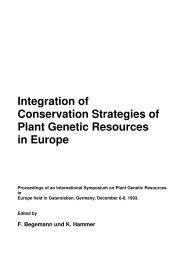Agrobiodiversität in Deutschland - Genres
Agrobiodiversität in Deutschland - Genres
Agrobiodiversität in Deutschland - Genres
Erfolgreiche ePaper selbst erstellen
Machen Sie aus Ihren PDF Publikationen ein blätterbares Flipbook mit unserer einzigartigen Google optimierten e-Paper Software.
22 | Johannes Engels<br />
From the earliest conservation and use activities<br />
of genetic resources until today<br />
Fig. 1: Domestication areas of our major crop plants, usually correspond<strong>in</strong>g with the primary centres of<br />
genetic diversity of the species<br />
Abb. 1: Domestikationszentren der Hauptkulturarten, <strong>in</strong> der Regel s<strong>in</strong>d dies auch die Primärzentren der<br />
genetischen Vielfalt dieser Arten<br />
Based on archaeological records it has been concluded that plant and animal<br />
domestication arose <strong>in</strong>dependently <strong>in</strong> at least seven, and possibly more,<br />
separate locations <strong>in</strong>dependently and as listed <strong>in</strong> Table 1. Besides the oldest<br />
centre of agricultural orig<strong>in</strong> and crop diversity, i.e. the Near East, with an<br />
estimated age of more than 13.500 years (!), also the ages of agricultural activities<br />
<strong>in</strong> the Americas dat<strong>in</strong>g back to about 10.000 and that of Papua New<br />
Gu<strong>in</strong>ea to approximately 9.000 years are strik<strong>in</strong>g. It should be remarked<br />
that only s<strong>in</strong>ce approximately 9.500 years agriculture and pastoralism <strong>in</strong><br />
the Fertile Crescent have become the dom<strong>in</strong>ant mode of subsistence for the<br />
majority of the population (Harris 1998).<br />
Tab. 1: Estimated dates of agricultural orig<strong>in</strong> of centres of plant domestication<br />
Tab. 1: Geschätzter Zeitpunkt des Beg<strong>in</strong>ns von Landwirtschaft <strong>in</strong> den<br />
Domestikationszentren<br />
Centers of domestication<br />
Average number of years<br />
before Christ (BC)<br />
1. Near East (<strong>in</strong> particular the Fertile Crescent) 11.500<br />
2. Northern /Southern Ch<strong>in</strong>a 6.000<br />
3. Central Mexico 6.500<br />
4. Americas 8.000<br />
5. Papua New Gu<strong>in</strong>ea 7.000<br />
6. West and Central Africa 2.000<br />
7. Eastern North America 2.500<br />
(Adapted from Dillehay 2007)<br />
It should be noted that these estimated dates of agricultural orig<strong>in</strong> that<br />
are based on more comprehensive and recent studies tend to <strong>in</strong>dicate that<br />
agricultural activities have started earlier than has been accepted for a long<br />
time. This is an important <strong>in</strong>dicator of the importance of migration of people<br />
as an eng<strong>in</strong>e of spread<strong>in</strong>g agriculture and crops around the world, either<br />
and predom<strong>in</strong>antly through coloniz<strong>in</strong>g new areas or through the adoption<br />
of domesticates by local foragers. Harris (1998) noted that agropastoralism<br />
can be seen as a “uniquely successful self-susta<strong>in</strong><strong>in</strong>g subsistence system<br />
which had a ‘built-<strong>in</strong>’ tendency to expand spatially and was not restricted<br />
territorially by a need for cont<strong>in</strong>ued access to wild plant and animal food”.<br />
Genetic diversity and plant collectors<br />
As already mentioned above, genetic diversity of crop plants has either been<br />
generated and adopted to local conditions through the domestication process<br />
and/or <strong>in</strong>troduction from elsewhere, l<strong>in</strong>ked to migration of foragers and<br />
farmers that moved around the world for many ten thousands of years. In<br />
Johannes Engels | 23










